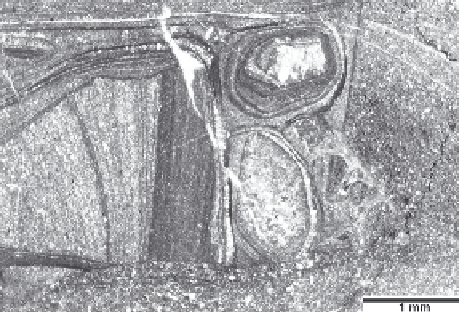Geology Reference
In-Depth Information
Association of Petroleum Geologists, Memoir,
33
, 1-54
Freytet, P., Plaziat, J.-C. (1982): Continental carbonate sedi-
mentation and pedogenesis. Late Cretaceous and Early
Tertiary of southern France. - Contributions to Sedimen-
tology,
12
, 1-213
Klappa, C.F. (1980): Rhizoliths in terrestrial carbonates: clas-
sification, recognition, genesis and significance. - Sedi-
mentology,
27
, 613-629
Klappa, C.F. (1983): A process-response model for the for-
mation of pedogenic calcretes. -In: Wilson, R.C.L. (ed.):
Residual deposits. - Geological Society, London, Special
Publication,
11
, 211-220
Gebhardt, U. (1988): Mikrofaziesanalyse und stratigraphisch-
regionale Interpretation terrestrischer Karbonate der varis-
zischen Molasse (Mitteleuropa, Permokarbon). - Frei-
berger Forschungshefte,
C 427
, 30-59
Reinhardt, J., Sigleo, W.R. (eds., 1988): Paleosols and
weathering through geologic time: principles and ap-
plication. - Geological Society of America, Special
Paper,
216
, 181 pp.
Read, J.F. (1976): Calcretes and their distinction from stro-
matolites. - In: Walter, M.R. (ed.): Stromatolites. - 55-
71, New York (Elsevier)
Retallak, G.J. (2001): Soils of the past. Second edition. -
416 pp., Oxford (Blackwell Sciences)
Theriault, P., Desrochers, A. (1993): Carboniferous calcretes
in the Canadian Arctic. - Sedimentology,
40
, 449-465
Wright, V.P. (ed., 1986): Paleosols. Their recognition and
interpretation. - 315 pp., Oxford (Blackwell)
Wright, V.P. (1994): Paleosols in shallow marine carbonate
sequences. - Earth Science Review,
35
, 367-395
Wright, V.P., Tucker, M.E. (eds., 1991): Calcretes. - Interna-
tional Association of Sedimentologists, Reprint Series,
2
,
352 pp.
Wright, V.P., Platt, N.H., Marriott, S.B., Beck, V.H. (1995):
A classification of rhizogenic (root-formed) calcretes, with
examples from Upper Jurassic-Lower Cretaceous of Spain
and Upper Cretaceous of southern France. - Sedimentary
Geology,
100
, 143-158
Further reading:
K030
sols, discolored rocks, terra rossa, breccias, and spe-
cific cavity fills. The recognition of paleokarst-related
disconformities has major implications for the inter-
preting sea-level history and defining a sequence-strati-
graphic framework.
One of the most spectacular features of
subsurface
karst
is the development of cave systems and voids
originating from meteoric dissolution. These caves are
places where the formation of various types of carbon-
ates (speleothems) and the precipitation of aragonite
and/or calcite in smaller voids (Pl. 129/4) take place.
Many caves exhibit infilling by cave sediments (Pl. 129/
2, 3) whose composition and fabric provide clues to
climate and hydrological conditions. A major feature
of surface and subsurface paleokarst are intraform-
ational karst breccias (Fig. 15.4; Pl. 129/1), which may
be hosts for mineral deposits, particularly lead-zinc-
sulfide deposits (see Sect. 17.2).
Paleokarst develops as depositional, local or inter-
regional paleokarst (see case studies in Choquette and
James 1988).
Depositional paleokarst is commonly associated
with meter-scale carbonate platform cycles. Local
paleokarst develops when only parts of platforms (e.g.
platform rims) are exposed, due to synsedimentary
block faulting or small drops in sea level. This is docu-
mented by the case study shown in Pl. 129. Interre-
gional paleokarst is related to major eustatic-tectonic
events and characterized by widespread karst terranes.
Distribution:
Paleokarst features have been reported
since the Archean, but became abundant in carbonate
15.2 Paleokarst
and Ancient Speleothems
Paleokarst is an ancient karst (see Sect. 2.4.1.3), com-
monly buried by younger sediments or sedimentary
rocks. Speleothems are carbonate sediments formed in
cave systems.
Karst is an aspect of lo
wstand conditions in the car-
bonate system. Humid climate favors karstification of
exposed carbonate platforms during sea level low-
stands. Rainwater charged with CO
3
penetrates fissures
and voids creating a karst landscape with collapse and
solution sinkholes, solution caves, dolines and under-
ground rivers. Karst features indicative of
subaerially
exposed karst
are dolines, rundkarren (rounded solu-
tion tunnels), kamnitzas (solution basins with circular
to oval outlines, flat bottoms and rounded edges), paleo-
Fig. 15.3.
Paleokarst breccias
caused by the collapse of cave
rocks and speleothem carbonates are characterized by a dis-
organized fabric, and clast-supported angular limestone clasts
in a size range of a few millimeters up to boulders more than
several tens of centimeters across. The thin section shows a
breccia consisting of angular clasts of pisolitic and fine-lami-
nated speleothem calcite of a paleokarst cave. Early Carbon-
iferous (Viséan): Holy Cross Mountains, Poland.

